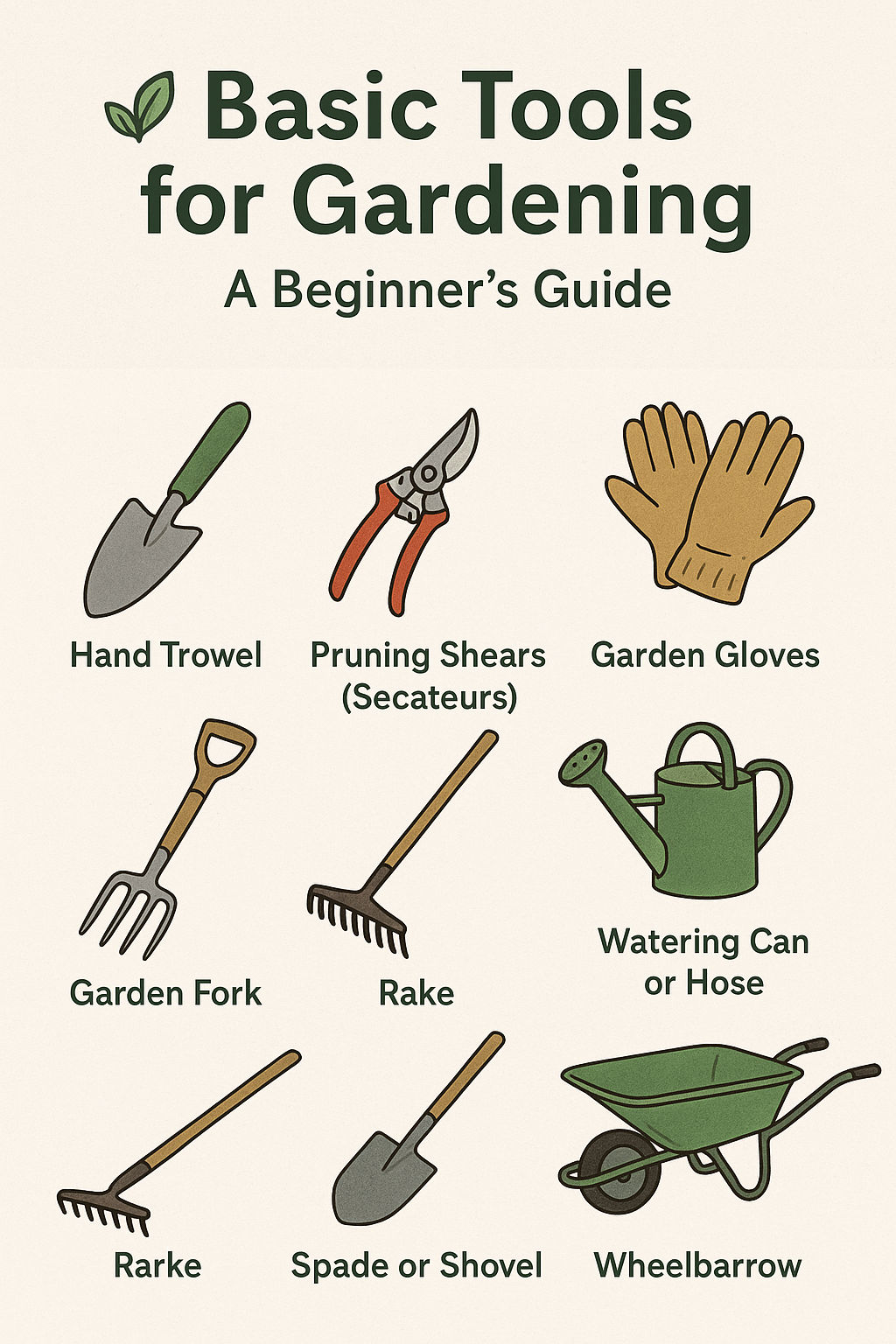🌿 GROWPlantWell – Nurture Nature, Transform Your Space 🌿
🛠 Basic Tools for Gardening: A Beginner’s Guide
Explore the essential basic gardening tools every beginner needs to grow a healthy garden. Learn tips on tool care, watering, pruning, and more to make gardening easy and enjoyable.
Grow Plant Well
8/12/20253 min read


🌿 Introduction
A beautiful garden starts with the right tools. Whether you’re planting flowers, growing vegetables, or tending to fruit trees, having a few essential gardening tools can make the job easier, faster, and more enjoyable. You don’t need an expensive collection—just a well-chosen set of basics to cover planting, watering, pruning, and maintenance.
🪴 1. Hand Trowel
The hand trowel is a gardener’s best friend. Perfect for digging small holes, transplanting seedlings, and planting bulbs, it’s a versatile must-have for garden beds and pots.
💡 Tip: Choose a trowel with a comfortable grip and rust-resistant blade.
✂️ 2. Pruning Shears (Secateurs)
Pruning shears are essential for trimming plants, cutting flowers, and removing dead growth. They help maintain plant health and encourage better blooming or fruiting.
💡 Tip: Keep blades sharp and clean to avoid damaging plants.
🌱 3. Garden Gloves
Protect your hands from thorns, blisters, and soil-borne bacteria with a sturdy pair of gloves. They also improve your grip on tools, especially when working with wet or muddy plants.
🌾 4. Watering Can or Hose
Water is life for plants. A watering can is great for precision watering, while a hose with a spray nozzle makes it easy to cover larger areas.
💡 Tip: Early morning watering reduces evaporation and plant stress.
🪓 5. Garden Fork
A garden fork is ideal for loosening compacted soil, turning compost, and aerating beds to improve root growth.
🧹 6. Rake
A rake helps clear leaves, grass clippings, and debris from lawns or garden beds. It’s also handy for spreading mulch evenly.
🛠 7. Spade or Shovel
For heavier digging tasks—such as planting trees, edging garden beds, or moving soil—a sturdy spade or shovel is indispensable.
🪵 8. Wheelbarrow
A wheelbarrow saves you multiple trips when transporting soil, compost, mulch, or heavy pots around the garden.
🌟 Quick Gardening Tool Care Tips
Clean after use – Prevents rust and disease spread.
Store in a dry place – Keeps wooden handles from rotting and metal from corroding.
Sharpen regularly – Easier cuts and less strain on hands.
🌿 Gardening Tools Q&A: Your Quick Guide
Q1: Do I really need all these tools to start gardening?
A: Not necessarily! Start with the basics like a hand trowel, gloves, and watering can. As you get more comfortable, you can add other tools like pruning shears or a garden fork.
Q2: How often should I clean my gardening tools?
A: It’s best to clean your tools after every use. This helps prevent rust and stops the spread of plant diseases.
Q3: Can I use any type of gloves for gardening?
A: Choose gloves that fit well and are made from durable materials. Some gloves are designed for specific tasks like pruning or handling wet soil.
Q4: What’s the difference between a spade and a shovel?
A: A spade has a flat, straight edge for digging and edging, while a shovel usually has a curved blade suited for scooping and moving soil or compost.
Q5: When is the best time to water my garden?
A: Early morning is ideal because it reduces water loss through evaporation and helps plants absorb water before the heat of the day.
Q6: How can I keep my pruning shears sharp?
A: Regularly clean them with soapy water, dry thoroughly, and use a sharpening tool or stone to maintain a sharp edge.
Q7: Is it worth investing in expensive gardening tools?
A: Quality tools last longer and often perform better. Start with good-quality basics, then upgrade as needed.
Q8: How do I store my gardening tools to keep them in good condition?
A: Store them in a dry, sheltered place like a shed or garage. Hanging tools or using racks helps keep them organized and prevents damage.
📌 Final Word
With these basic gardening tools, you can tackle most planting and maintenance tasks with ease. Start with the essentials, invest in quality, and care for your tools—your garden (and your back!) will thank you.